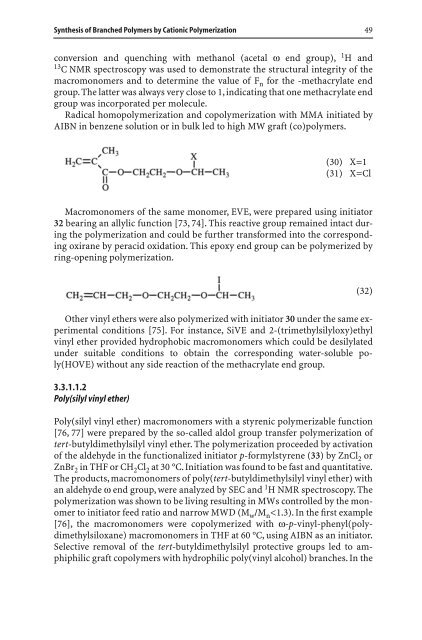142 Advances in Polymer Science Editorial Board: A. Abe. A.-C ...
142 Advances in Polymer Science Editorial Board: A. Abe. A.-C ...
142 Advances in Polymer Science Editorial Board: A. Abe. A.-C ...
You also want an ePaper? Increase the reach of your titles
YUMPU automatically turns print PDFs into web optimized ePapers that Google loves.
Synthesis of Branched <strong>Polymer</strong>s by Cationic <strong>Polymer</strong>ization 49<br />
conversion and quench<strong>in</strong>g with methanol (acetal w end group), 1 H and<br />
13 C NMR spectroscopy was used to demonstrate the structural <strong>in</strong>tegrity of the<br />
macromonomers and to determ<strong>in</strong>e the value of F n for the -methacrylate end<br />
group. The latter was always very close to 1, <strong>in</strong>dicat<strong>in</strong>g that one methacrylate end<br />
group was <strong>in</strong>corporated per molecule.<br />
Radical homopolymerization and copolymerization with MMA <strong>in</strong>itiated by<br />
AIBN <strong>in</strong> benzene solution or <strong>in</strong> bulk led to high MW graft (co)polymers.<br />
Macromonomers of the same monomer, EVE, were prepared us<strong>in</strong>g <strong>in</strong>itiator<br />
32 bear<strong>in</strong>g an allylic function [73, 74]. This reactive group rema<strong>in</strong>ed <strong>in</strong>tact dur<strong>in</strong>g<br />
the polymerization and could be further transformed <strong>in</strong>to the correspond<strong>in</strong>g<br />
oxirane by peracid oxidation. This epoxy end group can be polymerized by<br />
r<strong>in</strong>g-open<strong>in</strong>g polymerization.<br />
(32)<br />
Other v<strong>in</strong>yl ethers were also polymerized with <strong>in</strong>itiator 30 under the same experimental<br />
conditions [75]. For <strong>in</strong>stance, SiVE and 2-(trimethylsilyloxy)ethyl<br />
v<strong>in</strong>yl ether provided hydrophobic macromonomers which could be desilylated<br />
under suitable conditions to obta<strong>in</strong> the correspond<strong>in</strong>g water-soluble poly(HOVE)<br />
without any side reaction of the methacrylate end group.<br />
3.3.1.1.2<br />
Poly(silyl v<strong>in</strong>yl ether)<br />
(30) X=1<br />
(31) X=Cl<br />
Poly(silyl v<strong>in</strong>yl ether) macromonomers with a styrenic polymerizable function<br />
[76, 77] were prepared by the so-called aldol group transfer polymerization of<br />
tert-butyldimethylsilyl v<strong>in</strong>yl ether. The polymerization proceeded by activation<br />
of the aldehyde <strong>in</strong> the functionalized <strong>in</strong>itiator p-formylstyrene (33) by ZnCl 2 or<br />
ZnBr 2 <strong>in</strong> THF or CH 2Cl 2 at 30 °C. Initiation was found to be fast and quantitative.<br />
The products, macromonomers of poly(tert-butyldimethylsilyl v<strong>in</strong>yl ether) with<br />
an aldehyde w end group, were analyzed by SEC and 1 H NMR spectroscopy. The<br />
polymerization was shown to be liv<strong>in</strong>g result<strong>in</strong>g <strong>in</strong> MWs controlled by the monomer<br />
to <strong>in</strong>itiator feed ratio and narrow MWD (M w/M n
















